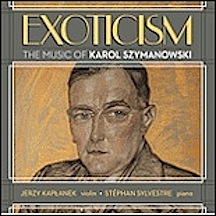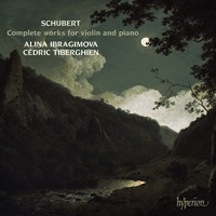 The chemistry of musical affinity is as elusive and powerful as the chemistry of love. A new album from Marquis by Penderecki String Quartet violinist Jerzy Kaplanek and pianist Stéphan Sylvestre of the music of Karol Szymanowsky makes for a fascinating study.
The chemistry of musical affinity is as elusive and powerful as the chemistry of love. A new album from Marquis by Penderecki String Quartet violinist Jerzy Kaplanek and pianist Stéphan Sylvestre of the music of Karol Szymanowsky makes for a fascinating study.
- Classical Music 101: What Does A Conductor Do? - June 17, 2019
- Classical Music 101 | What Does Period Instrument Mean? - May 6, 2019
- CLASSICAL MUSIC 101 | What Does It Mean To Be In Tune? - April 23, 2019
First, the chemistry that works: Kaplanek, who teaches at Wilfrid Laurier University, and Sylvestre, who teaches down the 401 at Western University, are a dream duo. Szymanowski’s difficult violin and piano writing treats the two parts as equal partners, and both players deliver interpretations that truly sound as if crafted in complete synch.
Both Kaplanek and Sylvestre display an easy technique and a deep appreciation for graceful phrasing and careful dynamic emphasis. The journey through these 63 minutes of music is at once deeply felt and elegantly modulated, without ever cutting Szymanowski’s bigger emotional outbursts short.
In short, this is what a duo performance is supposed to sound like.
The chemistry that doesn’t work, for me, is Szymanowski’s own writing. But it’s not for lack of fine ingredients.
The well-born Polish composer (1882) whose life was cut short by tuberculosis in 1937 had found his own voice in a heady mix of chromatic tonality — like Max Reger (1873-1916) but more focused. Like many of his Edwardian peers, Szymanowski excelled at tone painting.
The album’s early works are a gorgeous transcription of a Prélude, Szymanowski’s Op. 1 from 1900, and the opening D minor Sonata, Op. 9, from 1904.
The rest of the album contains a transcription of an aria from Szymanowski’s opera King Roger, from 1924, and little tone poems lasting 5 to 7 minutes, all from 1915: a Nocturne, Tarantella and Mythes, three pieces inspired by Greek antiquity.
What we get from these scores is the dating site equivalent of an ideal match, where the questionnaire turns up check marks in all the right places and the photos show off an attractive aspect. But then comes the first date…
Despite a wealth of exotic harmonies, arcing melodies and a blend of atmosphere and fire, the music failed to connect with me. Yes, it can be — and largely is — beautiful and so nicely performed here.
So what’s the problem?
One day, the right brain scans paired with a couple of well-wrought algorithms will show us which harmonic progressions and which intervals in a melody set off our metaphoric musical salivary glands.
In the meantime, after repeated listens to these pieces, I point to two related factors: Szymanowski doesn’t spend enough time developing each musical thought before he dashes off to the next one; and he focuses on delivering mood at the expense of thematic tension.
Because the music of Wagner and Richard Strauss finds echoes here, it’s interesting to compare how each of the two German-speakers knew how to stretch themes and their developments like taffy, unconsciously impelling our attention forward to the very end of a piece, no matter how distant.
Szymanowski doesn’t. But that doesn’t mean there isn’t a lot to enjoy, especially if you prefer living in the musical moment rather than seeking a bigger picture.
You’ll find all the details here.
+++
 I have another example of violin-and-piano chemistry to put forward: A new Hyperion 2-CD album of the complete works for violin and piano by Franz Schubert (1797-1828), interpreted by pianist Cédric Tiberghien and violinist Alina Ibragimova.
I have another example of violin-and-piano chemistry to put forward: A new Hyperion 2-CD album of the complete works for violin and piano by Franz Schubert (1797-1828), interpreted by pianist Cédric Tiberghien and violinist Alina Ibragimova.
Here, the composer’s musical chemistry is undeniable, as Schubert sings his way through light and dark. The most arresting piece on the album is the C Major Fantasy, D934, from 1827, a remarkable journey from introversion to extroversion and back again, over four movements.
In this instance, though, I wasn’t taken by the chemistry between violinist and pianist (who have performed together a lot).
Again, in theory, this should be a dream scenario, blending Tiberghien’s seductive sensitivity with Ibragimova’s captivating virtuosity. How many successful couples do we know where opposite-temperament partners become something greater than each other?
Despite some very fine playing and clear partnership, I emerged from the music feeling like each musician had somehow been diminished slightly by the other: Tiberghien not as compellingly nuanced as he could be, and Ibragimova’s steel-edged bow puncturing the mood a few times too many.
This is, first and foremost, chamber music, and this duo never credibly finds its stride in this small space. The players keep tiptoeing onto the big concert stage to blink furiously in the bright lights before retreating to the salon once again.
You can find all the details here — and there’s a free download available of the Allegretto from the Fantasy as a teaser.
John Terauds
- Classical Music 101: What Does A Conductor Do? - June 17, 2019
- Classical Music 101 | What Does Period Instrument Mean? - May 6, 2019
- CLASSICAL MUSIC 101 | What Does It Mean To Be In Tune? - April 23, 2019




